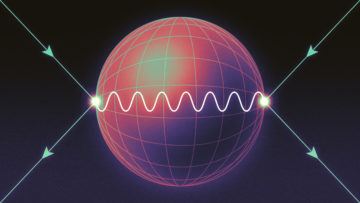Katie McCormick in Quanta:
 Last year, the particle physicist Lance Dixon was preparing a lecture when he noticed a striking similarity between two formulas that he planned to include in his slides.
Last year, the particle physicist Lance Dixon was preparing a lecture when he noticed a striking similarity between two formulas that he planned to include in his slides.
The formulas, called scattering amplitudes, give the probabilities of possible outcomes of particle collisions. One of the scattering amplitudes represented the probability of two gluon particles colliding and producing four gluons; the other gave the probability of two gluons colliding to produce a gluon and a Higgs particle.
“I was getting a little confused because they looked kind of similar,” said Dixon, who is a professor at Stanford University, “and then I realized that the numbers were basically the same — it’s just that the [order] had gotten reversed.”
He shared his observation with his collaborators over Zoom. Knowing of no reason the two scattering amplitudes should correspond, the group thought perhaps it was a coincidence.
More here.
